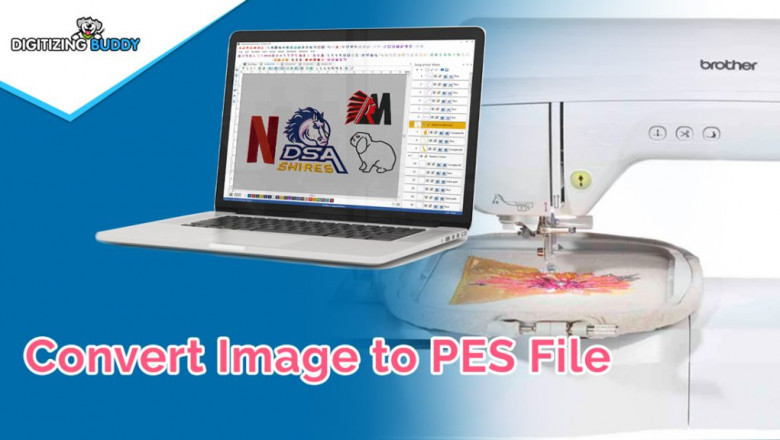views
If you've ever tried to embroider a design straight from a JPEG or PNG file, you probably ended up with a mess of tangled threads and frustration. That’s because embroidery machines don’t speak the same language as your computer’s photo viewer—they need specialized to convert image to PES file to stitch accurately.
In this guide, we’ll break down:
✔ What PES files are (and why they matter)
✔ How converting images to PES improves embroidery quality
✔ Step-by-step conversion methods (including free options)
✔ Common mistakes to avoid
✔ When to hire a pro vs. DIY conversion
Let’s turn your favorite images into stitch-perfect embroidery designs!
What Is a PES File?
A PES file is the embroidery world’s equivalent of a GPS. It’s a digital instruction manual that tells your Brother embroidery machine:
- Where to place each stitch
- What color thread to use
- How dense the stitches should be
- The order to stitch each section
Why PES Dominates Embroidery
- Brother’s default format (used in PE-Design, Babylock, and home machines)
- Stores critical data like thread changes and stitch sequencing
- Widely compatible with other software via conversion
Fun Fact: PES stands for "PE-Design Stitch"—Brother’s proprietary format since the 1990s.
5 Reasons You MUST Convert Images to PES Before Embroidering
1. Machines Can’t Read Regular Image Files
Your embroidery machine doesn’t understand pixels—it needs stitch coordinates. A PES file translates:
❌ JPEG/PNG: "Here’s a picture of a flower"
✅ PES: "Stitch 542 red satin stitches at 45° angle, then switch to green fill stitches"
Real-World Example: A bakery tried embroidering their logo straight from a PNG. The result? A blob of thread. After PES conversion, their cupcakes stitched perfectly.
2. Avoid Design Distortion
Auto-converted designs often:
- Lose small details (like fine text)
- Misinterpret colors
- Create uneven stitch density
PES files preserve:
✔ Sharp edges
✔ Consistent stitch spacing
✔ Accurate color blocking
3. Save Time & Money
- Fewer test runs (PES files stitch correctly the first time)
- Less thread waste (optimized stitch paths)
- No rehooping (prevents misaligned designs)
Cost Saver: Proper PES conversion reduces failed projects by up to 70% (Embroidery Trade Association, 2023).
4. Unlock Advanced Editing
PES files allow you to:
- Resize without quality loss
- Edit individual stitch points
- Add machine-specific effects (like 3D puff)
Pro Tip: Always keep the original PES file—it’s your master copy for future edits.
5. Ensure Brother Machine Compatibility
While some machines read multiple formats (like DST or EXP), PES guarantees smooth performance on:
- Brother SE1900
- PE-800
- Babylock Flourish
- Most home embroidery machines
How to Convert Images to PES: 3 Reliable Methods
Method 1: Professional Digitizing Services
Best for: Logos, complex artwork, bulk orders
How it works:
- Upload your image (PNG, JPEG, AI) to a service like Digitizing Buddy or Absolute Digitizing.
- Specify requirements (size, fabric type, stitch count).
- Receive a professionally digitized PES file in 24–48 hours.
Cost: 10–10–50 per design (worth it for business use).
Method 2: Embroidery Software
Best for: DIYers willing to learn
Top Options:
|
Software |
Price |
Learning Curve |
|
Embrilliance |
$199 |
Beginner-friendly |
|
SewArt |
$75 |
Moderate |
|
Wilcom Hatch |
$1,200+ |
Professional |
Basic Steps:
- Import image into software.
- Trace outlines (auto or manual).
- Assign stitch types (satin, fill, etc.).
- Export as PES.
Pro Tip: Start with free trials before buying software.
Method 3: Free Online Converters
Best for: Simple designs, one-time projects
Try These (With Caution):
- InkStitch (free plugin for Inkscape)
- MyEditor (web-based, limited functionality)
Limitations:
- Often produce jagged edges
- No stitch optimization
- Risk of corrupted files
Only use for: Non-critical projects like personal crafts.
5 Common PES Conversion Mistakes to Avoid
1. Using Low-Resolution Images
❌ Blurry JPEG → Pixelated stitches
✅ Fix: Start with 300+ DPI vector files (AI, EPS).
2. Ignoring Fabric Type
❌ Same PES file for towels and spandex
✅ Fix: Specify material when ordering digitizing.
3. Skipping Test Stitches
❌ Embroidering 50 hats without a sample
✅ Fix: Stitch on scrap fabric first.
4. Overlooking Hoop Size
❌ 6" design in a 4" hoop
✅ Fix: Match PES dimensions to your hoop.
5. Forgetting Thread Colors
❌ Machine defaults to wrong shades
✅ Fix: Manually set thread colors in software.
PES vs. Other Embroidery Formats
|
Format |
Best For |
Pros |
Cons |
|
PES |
Brother machines |
Easy to edit, home-friendly |
Limited to Brother/Babylock |
|
DST |
Commercial machines |
Industry standard |
Harder to edit |
|
EXP |
Melco/Bernina |
High stitch precision |
Less compatible |
|
JEF |
Janome |
Compact file size |
Brand-specific |
Key Takeaway: Always check your machine’s manual for supported formats.
When to DIY vs. Hire a Pro
DIY Conversion Works For:
- Simple shapes (hearts, stars)
- Personal projects
- Learning the basics
Hire a Pro When:
- Your logo has gradients/small text
- Embroidering merchandise for sale
- Using specialty fabrics (towels, caps)
Cost Comparison:
- DIY Software: 50–50–300 upfront
- Pro Digitizing: 15–15–50 per file
Final Thoughts: Stitch With Confidence
Converting images to PES isn’t just a technical step—it’s the difference between amateur and professional results. Whether you:
- Sell custom apparel
- Personalize gifts
- Create patches
...a proper PES file ensures your designs stitch smoothly, accurately, and durably.
Next Steps:
- Audit your image files—are they high-res enough?
- Try a pro digitizing service for your next project.
- Save your PES files like gold—they’re reusable!
Got a PES conversion horror story or success tip? Share it below! 👇














Comments
0 comment